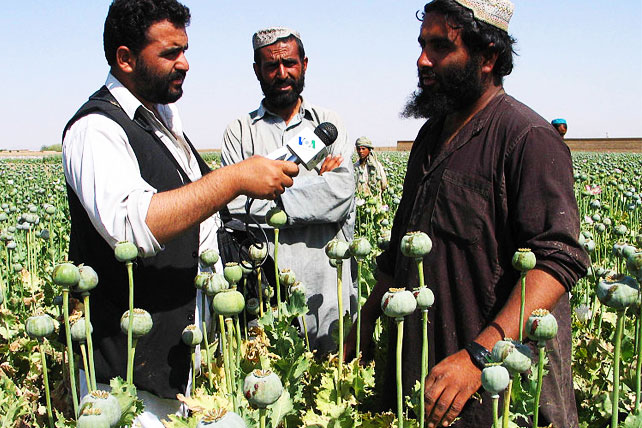With the purchase of a pomegranate snack bar at the local grocery store, a fruit tree is planted in Afghanistan and a little less illegal opium exists in the world – or so the story goes.
The Plant for Peace Foundation, an alternative development initiative that started in 2007, claims to have encouraged over 22,000 farmers in Afghanistan to grow mulberries, pomegranates, nuts, and apricots instead of opium poppies.
While relatively low profitability typically dissuades farmers from substituting licit crops for illicit crops, pomegranates have become a particularly lucrative crop to grow. Soon after Plant for Peace was established, a representative of the US Agency for International Development (USAID) claimed that Afghan farmers could earn around $2,000 for every 4,000 squares metres of cultivated pomegranates, compared with an estimated $1,320 for 4,000 squares metres of poppies.
Following the fruits’ harvest under the responsibility of the Plant for Peace Foundation, they are processed into snack bars by Plant for Peace Ltd, and are sold in the UK. For every bar sold in the UK, Plant for Peace plants a tree sapling in Afghanistan that will provide a farmer with an estimated $700 of fruit in its lifetime.
As the official website states, by providing people with a viable alternative to involvement in illicit drug production, the organisation aims to “create stability in troubled areas of the world by empowering communities.”
Since its inception, Plant for Peace has been heralded in the media for successfully subverting the illicit opium trade. In 2009, the organisation received a grant from USAID to plant 100,000 pomegranate cuttings. More recently, in May 2017, the UK government provided them with funding to continue their endeavours. Prominent figures, such as Prince Charles, have expressed interest in the initiative.
Plant for Peace snack bars are being sold at major supermarket chains around the UK, and its increased funding and attention suggests that the organisation's reach is bound to expand. But how much good is it, and similar initiatives, really doing?

Harvested poppy capsules (Source: Wikimedia)
Providing legal crop alternatives for farmers involved in the production of illicit drugs is known as alternative development (AD). This approach has been used in drug producing regions, from Colombia to Myanmar, to replace crops such as poppies and coca leaves with legal produce; it is a counter-narcotic strategy celebrated by many national and international governing bodies, including the United Nations. While this approach can undoubtedly improve the lives of individual farmers in the short-term, it does little to reduce illegal drug production globally – in fact, it may be increasing it.
In her 2015 paper entitled Drugs and Development: The Great Disconnect, Julia Buxton – the Senior Research Associate at Swansea University’s Global Drug Policy Observatory – warned that there is an inherent problem in AD: it relies on a confused understanding of the forces of supply and demand in the illicit drug market. The AD model expects that by driving supply down, prices will increase so much that consumers will be driven out of the market. However, in reality, people will continue to pay the higher costs, which in turn increases the value of the product; subsequently there becomes a larger financial incentive for people to produce the drug.
Furthermore, production costs have a relatively minimal effect on illicit drug prices. Even if legal crops – such as pomegranates – are initially more lucrative than illicit drug crops, the drug cultivation industry is positioned to offer competitive compensation to farmers. As author and public policy analyst Kevin Jack Riley explains, “Using source country price increases to create domestic scarcities is similar to attempting to raise glass prices by pushing sand back into the sea.”
As Buxton corroborates, the “viability of global supply reduction efforts through national level counter narcotics programmes [is limited]”.
Indeed, examining opium production trends on an international scale reveals what is known as the “balloon effect”: when supply decreases in one nation, other producing regions often compensate to meet the existing demand. For example, in the 1950s, opium supply reduction in Iran and China was accompanied by an increase in production in Turkey, Myanmar, Laos, Vietnam, and Thailand. When Thailand and Turkey subsequently adopted measures to reduce opium production, Myanmar and Afghanistan supplied more to meet demand.
This phenomenon is not unique to the opium trade; suppression of the coca trade led to a move in coca leaf cultivation from Peru and Bolivia to Colombia in the 1990s. Counter-narcotic supply-targeting measures, including aerial fumigation of crops, then saw coca production gradually shift from Colombia back to neighbouring countries over the following decades.
The positive impact of Plant for Peace on the individual lives of farmers is certainly commendable. However, drawing on Buxton’s warnings, it is important to recognise that creating and celebrating this success must not detract from critical engagement with the limitations of AD. As Buxton notes in the concluding reflections of her paper, it is urgent for policymakers to critically consider the “feasibility of development objectives within a prohibition oriented drug control framework”.
It is the conceptualisation of drugs and the drug war that must be overhauled for real, substantial change that goes beyond shifting drug supply operations between countries. Buying this snack bar is no guarantee that there will be any less opium in the world.


